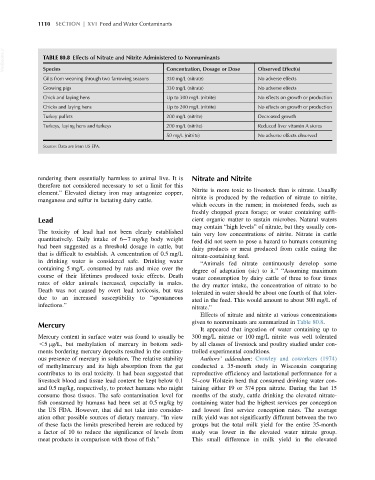Page 1178 - Veterinary Toxicology, Basic and Clinical Principles, 3rd Edition
P. 1178
1110 SECTION | XVI Feed and Water Contaminants
VetBooks.ir TABLE 80.8 Effects of Nitrate and Nitrite Administered to Nonruminants Observed Effect(s)
Species
Concentration, Dosage or Dose
Gilts from weaning through two farrowing seasons 330 mg/L (nitrate) No adverse effects
Growing pigs 330 mg/L (nitrate) No adverse effects
Chick and laying hens Up to 300 mg/L (nitrite) No effects on growth or production
Chicks and laying hens Up to 200 mg/L (nitrite) No effects on growth or production
Turkey pullets 200 mg/L (nitrite) Decreased growth
Turkeys, laying hens and turkeys 200 mg/L (nitrite) Reduced liver vitamin A stores
50 mg/L (nitrite) No adverse effects observed
Source: Data are from US EPA.
rendering them essentially harmless to animal live. It is Nitrate and Nitrite
therefore not considered necessary to set a limit for this
Nitrite is more toxic to livestock than is nitrate. Usually
element.” Elevated dietary iron may antagonize copper,
nitrite is produced by the reduction of nitrate to nitrite,
manganese and sulfur in lactating dairy cattle.
which occurs in the rumen; in moistened feeds, such as
freshly chopped green forage; or water containing suffi-
Lead cient organic matter to sustain microbes. Natural waters
may contain “high levels” of nitrate, but they usually con-
The toxicity of lead had not been clearly established
tain very low concentrations of nitrite. Nitrate in cattle
quantitatively. Daily intake of 6 7 mg/kg body weight
feed did not seem to pose a hazard to humans consuming
had been suggested as a threshold dosage in cattle, but
dairy products or meat produced from cattle eating the
that is difficult to establish. A concentration of 0.5 mg/L
nitrate-containing feed.
in drinking water is considered safe. Drinking water
“Animals fed nitrate continuously develop some
containing 5 mg/L consumed by rats and mice over the
degree of adaptation (sic) to it.” “Assuming maximum
course of their lifetimes produced toxic effects. Death
water consumption by dairy cattle of three to four times
rates of older animals increased, especially in males.
the dry matter intake, the concentration of nitrate to be
Death was not caused by overt lead toxicosis, but was
tolerated in water should be about one fourth of that toler-
due to an increased susceptibility to “spontaneous
ated in the feed. This would amount to about 300 mg/L of
infections.” nitrate.”
Effects of nitrate and nitrite at various concentrations
Mercury given to nonruminants are summarized in Table 80.8.
It appeared that ingestion of water containing up to
Mercury content in surface water was found to usually be 300 mg/L nitrate or 100 mg/L nitrite was well tolerated
,5 μg/L, but methylation of mercury in bottom sedi- by all classes of livestock and poultry studied under con-
ments bordering mercury deposits resulted in the continu- trolled experimental conditions.
ous presence of mercury in solution. The relative stability Authors’ addendum: Crowley and coworkers (1974)
of methylmercury and its high absorption from the gut conducted a 35-month study in Wisconsin comparing
contributes to its oral toxicity. It had been suggested that reproductive efficiency and lactational performance for a
livestock blood and tissue lead content be kept below 0.1 54-cow Holstein herd that consumed drinking water con-
and 0.5 mg/kg, respectively, to protect humans who might taining either 19 or 374 ppm nitrate. During the last 15
consume those tissues. The safe contamination level for months of the study, cattle drinking the elevated nitrate-
fish consumed by humans had been set at 0.5 mg/kg by containing water had the highest services per conception
the US FDA. However, that did not take into consider- and lowest first service conception rates. The average
ation other possible sources of dietary mercury. “In view milk yield was not significantly different between the two
of these facts the limits prescribed herein are reduced by groups but the total milk yield for the entire 35-month
a factor of 10 to reduce the significance of levels from study was lower in the elevated water nitrate group.
meat products in comparison with those of fish.” This small difference in milk yield in the elevated

